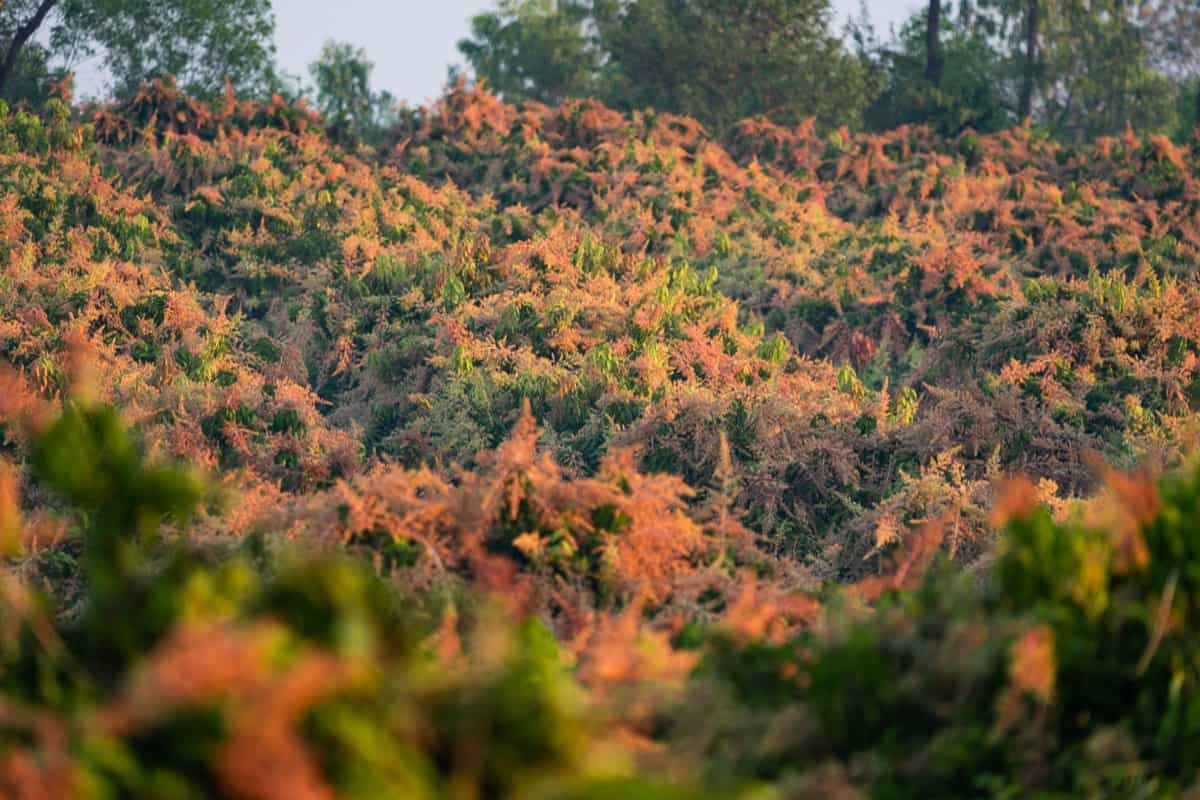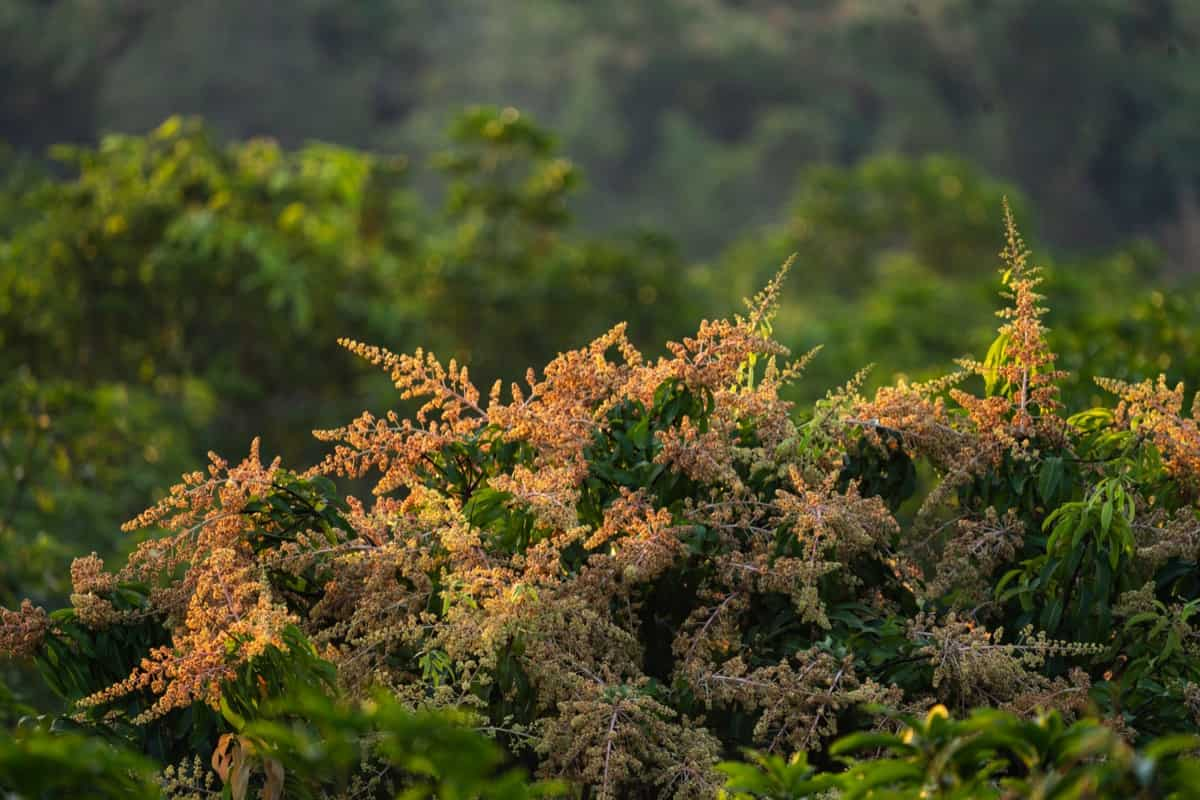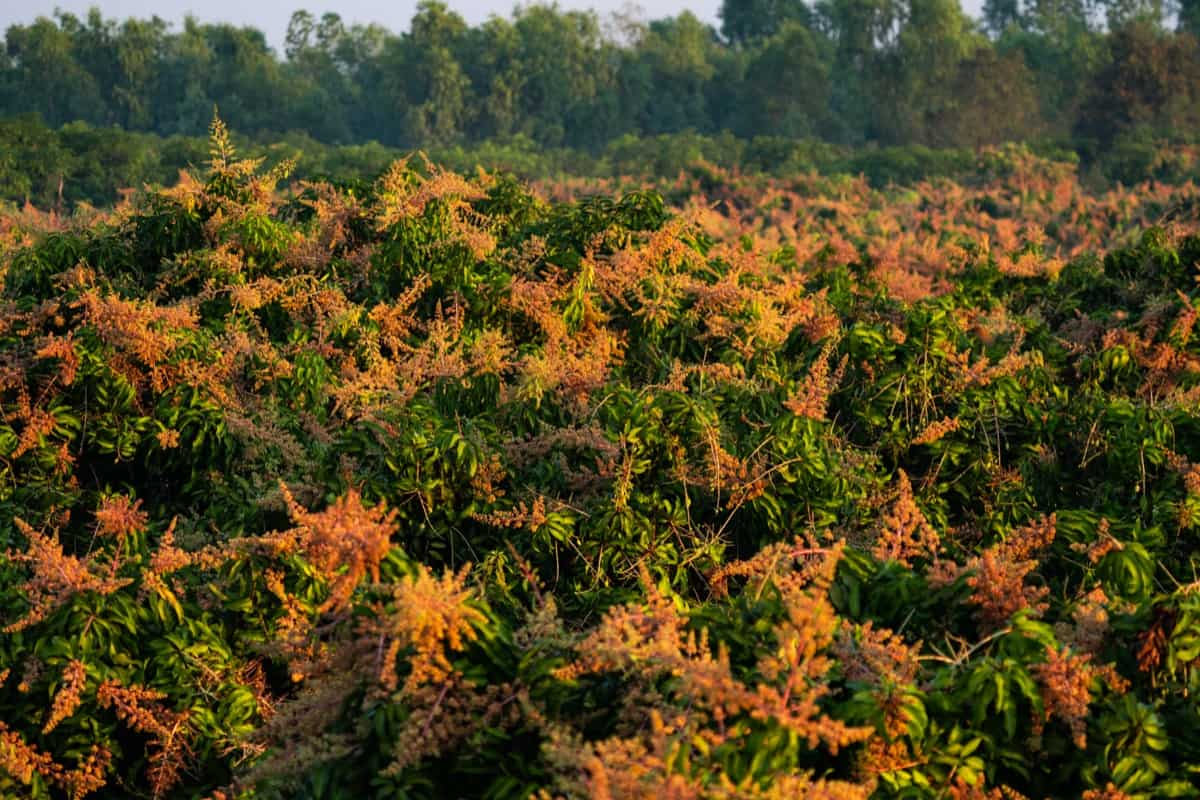The drop of Mango flowers and fruits can be a frustrating problem for any Mango tree owner. What is the fruit drop in Mango? Fruit drop, or premature fruit shedding, refers to the phenomenon where Mango trees shed their developing fruits before they reach maturity. This can be a frustrating problem for home gardeners and commercial growers, leading to reduced yield and economic losses.

How to take care of a flowering Mango tree? Caring for a flowering Mango tree is crucial to ensure a bountiful harvest. Maintaining good hygiene in your garden by removing fallen leaves and fruits can help reduce fungal diseases contributing to flower and fruit drop. Remember that prevention is key when addressing flower and fruit drop in Mango trees. Providing optimal growing conditions during flowering and fruiting stages and promptly addressing potential causes through preventive measures will greatly increase the harvest.
How to Stop Mango Flower Drop and Fruit Drop
Understanding the Causes of Mango Flower and Fruit Drop
Mango flower and fruit drop can be a frustrating problem for Mango growers, as it significantly reduces the potential yield of their trees. Understanding the causes behind this phenomenon is crucial to address and prevent it effectively. One common cause of Mango flower and fruit drop is environmental stress. Extreme hot and cold temperatures can disrupt the flowering and fruiting process.
Additionally, fluctuations in humidity levels or prolonged periods of drought can lead to flower and fruit drop. Another factor that contributes to this issue is poor pollination. Mango flowers may not receive proper fertilization if there are not enough bees or other pollinators in the area, resulting in dropped or undeveloped fruits. Pests and diseases can also affect Mango flowers and fruit drop.
Insects such as thrips or mites can damage flowers or developing fruits, causing them to fall prematurely. Diseases like anthracnose or powdery mildew can weaken the tree’s health, leading to increased flower drop. Furthermore, nutrient deficiencies or imbalances within the soil can negatively impact flowering and fruit set. Insufficient key nutrients like nitrogen, phosphorus, potassium, magnesium, zinc, or boron can hinder the proper development of flowers and fruits.
Implementing Proper Cultural Practices to Prevent Mango Flower and Fruit Drop
Regular pruning of Mango trees can also help prevent flower and fruit drop. Pruning helps maintain an open canopy, allowing sunlight to penetrate the tree, promoting better flowering and fruit set. Proper watering techniques are also crucial in preventing flower and fruit drop. Mango trees require regular deep watering but should not be overwatered or allowed to sit in waterlogged conditions, as this can cause root damage and ultimately result in flower and fruit loss.
Fertilizer management plays a vital role as well. It’s important to apply balanced fertilizers containing nitrogen, phosphorus, potassium, and micronutrients like zinc and magnesium during the growing season. Controlling pests such as aphids, mealybugs, or mites is another critical step in preventing flower and fruit drop.
Regular monitoring of infestations allows for timely intervention using organic or chemical pest control methods if necessary. Providing adequate protection from extreme weather conditions such as strong winds or heavy rains can help minimize stress on the Mango trees’ flowers and fruits, reducing the chances of dropping prematurely.
Managing Pests and Diseases to Minimize Mango Flower and Fruit Drop
The key factor that can cause Mango flower and fruit drop is the presence of pests and diseases. These unwanted visitors cause damage to both the flowers and fruits. Therefore, it is crucial to manage these issues effectively to minimize flower and fruit drop. Regular monitoring of your Mango trees is essential. Early detection allows for prompt action, preventing further damage. You can employ various methods, such as biological control agents or organic insecticides, to manage pests.
Natural predators like ladybugs or lacewings can help keep pest populations in check without harming beneficial insects or pollinators. For diseases, practicing good sanitation measures is important. Remove fallen leaves or debris around the tree as they may harbor pathogens. Also, ensure proper air circulation by pruning overcrowded branches. In addition, applying appropriate fungicides at recommended intervals can help prevent fungal infections contributing to flower and fruit drop.
Optimizing Irrigation and Nutrient Management for Mango Trees
Proper irrigation and nutrient management prevent Mango flower and fruit drop. Ensuring your Mango trees receive the right amount of water and nutrients can promote healthy growth and improve the fruit set. When it comes to irrigation, it’s important to strike a balance. Mango trees require regular watering, especially during dry periods, but overwatering can lead to root rot or fungal infections.
The key is providing enough moisture to moisten the soil but not waterlogged. To achieve this balance, consider drip irrigation systems delivering water directly to the roots. This method reduces evaporation and minimizes weed growth around the tree base. It also helps prevent excessive wetting of foliage, which can increase disease incidence.
Regarding nutrient management, Mango trees have specific requirements throughout their growth cycle. During flowering and fruiting stages, they need higher quantities of potassium and phosphorus. Nitrogen should be applied sparingly during these stages as excess nitrogen can result in vegetative growth at the expense of flowers and fruits.
Pruning Techniques for Controlling Mango Flower and Fruit Drop
Regular pruning helps to improve air circulation and sunlight penetration within the canopy. This promotes better tree health and reduces the chances of diseases or pests causing flower and fruit drop. Removing dead or diseased branches enhances the tree’s aesthetic appeal and prevents potential infection from spreading throughout the canopy. Moreover, selective thinning of branches can help balance the tree’s energy distribution.
By removing excessive growth, nutrients are redirected toward developing healthy flowers and fruits instead of being wasted on unproductive vegetative growth. It is important to note that pruning should be done during specific times in a Mango tree’s life cycle. Pruning after harvest encourages new growth for next year’s flowering season. However, avoid heavy pruning immediately before or during flowering, which may disrupt pollination processes. Additionally, using clean and sharp tools for pruning ensures minimal tree damage while promoting faster wound healing.
Protecting Mango Trees from Environmental Stressors to Prevent Flower and Fruit Drop
Like any other plant, Mango trees are susceptible to environmental stressors that can lead to flower and fruit drop. These stressors include extreme temperatures, drought, excessive rainfall, strong winds, and pollution. Providing proper shelter for the trees is essential. Erecting windbreaks or using shade cloths can help shield the Mango tree from strong winds or intense sunlight. This way, the tree’s delicate flowers, and fruits won’t be easily damaged by harsh weather conditions.
In case you missed it: Mango Tree Fertilization: Schedule, Application Process

Maintaining a consistent watering schedule is crucial in preventing flower and fruit drop caused by drought or excessive rainfall. Proper irrigation techniques or installing mulch around the tree’s base can help regulate soil moisture levels effectively. Moreover, monitoring soil fertility and nutrient levels is vital for Mango tree health. Conducting soil tests will ensure that nutrients are available in optimal quantities for sustained growth and development of flowers and fruits.
Enhancing Pollination to Reduce Mango Flower and Fruit Drop
Mango flowering spray is a popular method farmers and gardeners use to promote healthy flower growth in Mango trees. This spray contains specific nutrients and hormones that help stimulate the tree’s natural flowering process. When using a Mango flowering spray, it is important to follow the instructions carefully. Dilute the spray according to the recommended dosage and apply it evenly on all tree parts, especially focusing on the branches where flowers are expected to bloom.
Pollination plays a crucial role in the successful fruit set of Mango trees. Insufficient or ineffective pollination can lead to flower drop and poor fruit development. You can employ several methods to enhance pollination and minimize flower and fruit drop. One effective method is attracting natural pollinators such as bees and butterflies to your Mango orchard.
These insects are excellent at transferring pollen from one flower to another, increasing the chances of successful fertilization. You can encourage their presence by planting flowering plants nearby or providing nesting sites. Timing is crucial when it comes to enhancing pollination in Mango trees. It’s important to observe when your trees start producing buds and open their first blooms so that you know when they’re most receptive to cross-pollination efforts.
Identifying and Addressing Common Disorders Causing Mango Flower and Fruit Drop
Identifying and addressing common disorders that cause Mango flower and fruit drop is crucial for maintaining a healthy and productive Mango tree. Several disorders can lead to this issue; understanding them is the first step in finding effective solutions. One common disorder is anthracnose, a fungal disease affecting Mango trees’ flowers and fruits. It causes dark spots on the flowers, eventually leading to flower drops.
To address this disorder, it is important to implement proper sanitation practices by removing infected plant material and using fungicides when necessary. Another disorder to look for is powdery mildew, a fungal infection characterized by white powdery patches on leaves, flowers, and fruits. This can also contribute to flower drops, weakening the tree’s health.
Preventive measures such as regular pruning to improve airflow and applying fungicides can help manage this issue. Nutrient deficiencies are another common cause of flower drops in Mango trees. Lack of essential nutrients like nitrogen or potassium can result in poor flowering and fruit set.
Regular soil tests will help identify deficiencies so they can be addressed through appropriate fertilization methods. Environmental stressors such as extreme temperatures or drought conditions can negatively impact Mango flower formation and fruit development. Providing adequate irrigation during dry periods or implementing shading techniques during hot spells can mitigate these stressors.
Monitoring and Maintaining Tree Health to Prevent Mango Flower and Fruit Drop
How to Control Fruit drop in Mango? Controlling fruit drop in Mango is essential for ensuring a bountiful harvest and maximizing the yield of this delicious tropical fruit. By understanding the causes of fruit drop and implementing effective control measures, Mango growers can minimize their losses and increase their profits.
Monitoring and maintaining the health of Mango trees is crucial to prevent flower and fruit drop. Regular monitoring allows you to detect signs of stress or diseases early on, enabling prompt intervention. Start by visually inspecting your trees for visible symptoms such as yellowing leaves, wilting branches, or insect infestations. Mango trees require well-drained soil but also need adequate moisture to thrive.
In case you missed it: Why Are My Mango Flowers Turning Brown and Dying: Reasons, Solutions, and Remedies

Maintaining proper nutrition is essential for healthy Mango tree growth and fruit production. Conduct regular soil tests to determine nutrient deficiencies and adjust fertilization accordingly. A balanced fertilizer with micronutrients specific to Mangoes can help optimize tree health. Pruning is vital in maintaining tree health and preventing flower and fruit drop. Remove dead or diseased branches regularly, allowing better air circulation within the canopy and reducing fungal infections.
Protect your Mango trees from extreme temperatures by providing shade during the hot summer or frost protection during winter if necessary. Mulching around the tree’s base helps retain moisture, regulate temperature, suppress weed growth, and provide organic matter as it decomposes. Mango flowering chemicals are an effective tool for controlling flower and fruit drop in Mango trees. These chemicals, also known as plant growth regulators or hormones, can help stimulate and regulate the natural processes of flowering and fruit development.
Conclusion
Mango flower drop and fruit drop can frustrate any Mango tree owner or enthusiast. However, by understanding the causes behind these issues and implementing effective prevention methods, you can significantly reduce the occurrence of flower drop and fruit drop in your Mango trees.
Remember to pay attention to weather conditions, nutrient deficiencies, pest infestations, improper pruning techniques, and excessive use of chemicals. You will increase the chances of a bountiful harvest by providing optimal growing conditions for your Mango trees and ensuring they receive adequate care throughout their growth cycle.
- Feed Your Flock for Less: Top 10 Tips to Save on Chicken Feed
- Ultimate Guide to Ossabaw Island Hog: Breeding, Raising, Diet, and Care
- Hatching Answers: The Top 10 Reasons Your Chickens Aren’t Laying Eggs
- Eggs and Economics: Breaking Down the Cost of Raising Backyard Chickens
- Defend Your Greens: Proven Methods to Keep Iguanas Out of Your Garden
- Ultimate Guide to Cinnamon Queen Chicken: A Comprehensive Guide for Beginners
- Ultimate Guide to California Tan Chicken: Breeding, Raising, Diet, Egg-Production and Care
- Ultimate Guide to Marsh Daisy Chicken: Breeding, Raising, Diet, and Care
- 10 Types of Chicken Farming Businesses You Can Start for Profits